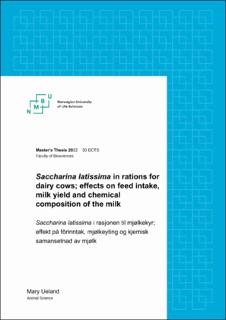| dc.contributor.advisor | Mydland, Liv Torunn | |
| dc.contributor.advisor | Khan, Ghulam Qasim | |
| dc.contributor.advisor | Prestløkken, Egil | |
| dc.contributor.author | Ueland, Mary | |
| dc.coverage.spatial | Norway | en_US |
| dc.date.accessioned | 2022-12-22T10:17:23Z | |
| dc.date.available | 2022-12-22T10:17:23Z | |
| dc.date.issued | 2022 | |
| dc.identifier.uri | https://hdl.handle.net/11250/3039209 | |
| dc.description.abstract | As the world’s population is increasing, this sets demands to an increased food production. One way that Norwegian agriculture can meet these demands is to increase the use of naturally given resources in a sustainable way. Research on how to increase efficiency in livestock production is a part of this. The aim of the current research was to investigate if addition of seaweed in the diet can make dairy cows more efficient firstly in the milk production, and secondly in ensuring the iodine intake in the Norwegian population.
A cross-over milk production experiment with six Norwegian Red dairy cows was conducted, where total mixed rations of grass silage and concentrate with the addition of either 1 % sugar kelp (Saccharina latissima) on dry matter basis (SW diet) or no additive as control (CON diet) were used. The effect of the seaweed inclusion on feed intake, milk production and the chemical composition of the milk was studied. The results showed a significant increase in dry matter intake (DMI) for the SW diet than the CON diet (P = 0.008), which may have led to a significantly higher milk yield (MY; P = 0.024). There was a tendency towards an increased milk fat concentration of the SW diet (P = 0.06) which together with the increased MY resulted in greater yield of energy corrected milk (ECM) in the SW diet than in the CON diet (P = 0.037). Moreover, daily yield of fat and protein was higher for the SW diet than the CON diet (P ≤ 0.046). The milk iodine in the SW diet was almost seven times higher than in the CON diet (P = 0.0032). No effect was observed on rumen fermentation products or nutrient digestibility, except a tendency (P = 0.083) to a higher ash digestibility in the SW diet.
The results point towards a clear positive effect with the seaweed inclusion in the diet as it causes a higher DMI and MY, without affecting the rumen environment. A clear explanation as to why these results were obtained was not found, hence this is a topic that should be studied closer with e.g., other inclusion levels of the seaweed, or for a longer time period to study the long-term effects. | en_US |
| dc.description.abstract | Ettersom befolkninga i verda aukar, set dette krav til ein auka matproduksjon. Ein måte norsk landbruk kan møta desse krava er å auka bruken av naturleg gjevne ressursar på ei berekraftig måte. Forskning på korleis å gjera husdyrproduksjonen meir effektiv er ein del av dette. Formålet med denne studien var å undersøka om tilsetning av sukkertare i fôret kan vera ein måte for å gjera mjølkekyr meir effektive først og fremst i mjølkeproduksjonen, og i andre rekke å sikra jodinntaket i den norske befolkninga. Det vart utført eit krysningsforsøk for mjølkeproduksjon med seks kyr av rasen Norsk raudt fe, der det vart brukt total blanda rasjon av grassurfôr og kraftfôr med anten 1 % sukkertare (Saccharina latissima) tilsett på tørrstoffbasis(tarediett) eller med inga tilsetning som kontroll. Effekten sukkertare hadde på fôrinntak, mjølkeproduksjon og mjølkesamansetnad vart undersøkt. Resultata viste eit signifikant høgare tørrstoffinntak av taredietten enn kontrolldietten (P = 0.008), som kan ha bidrege til signifikant høgare mjølkeyting (P = 0.024). Det var ein tendens til auka konsentrasjon av mjølkefeitt for taredietten (P = 0.06) som saman med auken i mjølkeyting resulterte i auka yting av energikorrigert mjølk (EKM) i taredietten samanlikna med kontrolldietten (P = 0.037). Dessutan var dagleg yting av feitt og protein høgare for taredietten enn for kontrolldietten (P ≤ 0.046). Jodinnhaldet i mjølk med taredietten var nesten sju gonger høgare enn frå kontrolldietten (P = 0.0032). Det vart ikkje observert nokon effekt på fermenteringsprodukt i vom eller på fordøyelse av næringsstoff, utanom ein tendens (P = 0.083) til høgare fordøyelse av oske i taredietten. Resultata peikar på ein tydeleg positiv effekt ved tilsetning av sukkertare i fôret ettersom det gav ei auke i både fôrinntak og mjølkeyting, utan å påverka vommiljøet. Det vart ikkje funne nokon spesifikk forklaring på resultata, derfor er dette eit tema som bør studerast nærmare med t.d. andre mengder tare i fôret, eller over lenger tid for å kunna vurdera langvarige effektar. | en_US |
| dc.language.iso | eng | en_US |
| dc.publisher | Norwegian University of Life Sciences, Ås | en_US |
| dc.rights | Attribution-NonCommercial-NoDerivatives 4.0 Internasjonal | * |
| dc.rights.uri | http://creativecommons.org/licenses/by-nc-nd/4.0/deed.no | * |
| dc.subject | Cattle | en_US |
| dc.subject | Dairy cows | en_US |
| dc.subject | Animal feeding | en_US |
| dc.subject | Saccharina latissima | en_US |
| dc.subject | Dairy products | en_US |
| dc.subject | Milk | en_US |
| dc.title | Saccharina latissim in rations for dairy cows : effects on feed intake, milk yield and chemical composition of the milk | en_US |
| dc.title.alternative | Saccharina latissima i rasjonen til mjølkekyr : effekt på fôrinntak, mjølkeyting og kjemisk samansetnad av mjølk | en_US |
| dc.type | Master thesis | en_US |
| dc.description.localcode | M-HV | en_US |

